Ralph Allen: The mayor of Bath of is now largely a ceremonial position, but Ralph Allen as mayor (elected in 1742) and postmaster of Bath, and most importantly as the owner of a quarry, defined the look of Bath. To his quarries and its honey-colored stone we owe the consistent Georgian look of the city
archbishop and bishops: the archbishops of Canterbury and York are the leaders of the Church of England, although the monarch, of course, is the head of the church. Bishops supervise the dioceses, ordain new priests, confirm the faithful and sit in the House of Lords.
assemblies: organizations that provided, for a subscription, balls, concerts, salons and suppers during the social season.
barrister: Britain has a split legal profession that includes barristers and solicitors (and at one time serjeants at law). Barristers can plead in court but don’t directly represent a client. Instead they are retained (or instructed) by a solicitor. More importantly, they are considered gentleman because they don’t directly take money from a client. In fact, there is a little pocket sewn into the back of a barrister’s robe into which a solicitor could slip a payment (there is some debate about this). Daniel Poole’s What Jane Austen Ate and Charles Dickens Knew is very informative about the legal profession.
 barouche, landau: a four wheeled carriage drawn by two horses with two benches, allowing the passengers to face each other across the middle, with a separate box for the driver, often protected by a folding cover. In Emma, Mrs. Elton speaking of her brother and sister: “They will have their barouche-landau, of course, which holds four perfectly.” I believe a landau to be similar to a barouche, probably larger and drawn by four horses. You would have seen Prince William and Princess Kate being taken back to Buckingham Palace from Westminster Abbey in one of the state landaus.
barouche, landau: a four wheeled carriage drawn by two horses with two benches, allowing the passengers to face each other across the middle, with a separate box for the driver, often protected by a folding cover. In Emma, Mrs. Elton speaking of her brother and sister: “They will have their barouche-landau, of course, which holds four perfectly.” I believe a landau to be similar to a barouche, probably larger and drawn by four horses. You would have seen Prince William and Princess Kate being taken back to Buckingham Palace from Westminster Abbey in one of the state landaus.
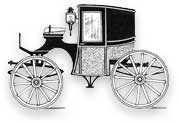 brougham: pronounced “broom,” this is a four-wheeled carriage for two, with a separate seat for the driver and perhaps a footman. Similar to the phaeton, but with a protected cab and glazed windows.
brougham: pronounced “broom,” this is a four-wheeled carriage for two, with a separate seat for the driver and perhaps a footman. Similar to the phaeton, but with a protected cab and glazed windows.
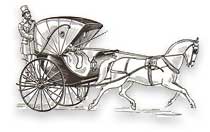 cabriolet: a two-wheeled carriage for two, one of who is the driver, drawn by a single horse. It has a folding top to cover the occupants and may have a platform in the rear for a groom to stand. Very similar to the Hansom cab, where it was driven by the person in back. From whence we get the word “taxi cab,” the taximeter being the device that tallied the distance.
cabriolet: a two-wheeled carriage for two, one of who is the driver, drawn by a single horse. It has a folding top to cover the occupants and may have a platform in the rear for a groom to stand. Very similar to the Hansom cab, where it was driven by the person in back. From whence we get the word “taxi cab,” the taximeter being the device that tallied the distance.
Court of St. James: St. James Palace is the official home of the British monarchy, although the sovereign has many royal residences, such as Buckingham and Windsor palaces. St. James Palace is a working palace, and foreign ambassadors are said to present their credentials to the court of St. James. Young ladies were also presented to the court, marking their “coming out,” meaning they had entered society and were considered eligible for marriage. And Sir William Lucas in Pride and Prejudice is presented to the court, presumably on the occasion of his knighthood.
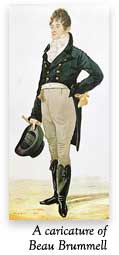 dandy, Beau Brummell: George Bryan Brummell was a trend setter in Regency England and a friend of the Prince Regent. Nowadays we might think of a dandy (a term coined by Lord Byron and describing the club to which Brummell belonged) as being outrageously dressed, but at the time Brummell favored simple but elegant, in some ways severe, clothing of high quality. Dandies were said to devote a lot of their time to their toilet, meaning they were meticulous about grooming, deportment, the cut of their trousers (Brummell favored trousers over breeches) and the polish of their shoes. Think of dandies as the first metrosexuals.
dandy, Beau Brummell: George Bryan Brummell was a trend setter in Regency England and a friend of the Prince Regent. Nowadays we might think of a dandy (a term coined by Lord Byron and describing the club to which Brummell belonged) as being outrageously dressed, but at the time Brummell favored simple but elegant, in some ways severe, clothing of high quality. Dandies were said to devote a lot of their time to their toilet, meaning they were meticulous about grooming, deportment, the cut of their trousers (Brummell favored trousers over breeches) and the polish of their shoes. Think of dandies as the first metrosexuals.
deacon, curate: the low man on the ecclesiastical totem pole. The deacon was a full-fledged clergyman but without the benefit of a benefice (living, see below). They basically did all the work and populate a lot of P.G. Wodehouse plots.
 look him up in Debrett’s: Since 1780 (with a few lapses) Debrett’s Peerage and Baronetage has been the who’s who of the English titled, and you see it referenced in Persuasion: “Sir Walter Elliot … was a man who … never took up any book but the Baronetage.” The entry mentions his name, birthdate and title, the date of his marriage and his wife’s name and her death, and the birthdates and names of his children. If someone claimed to be Lord So and So, you could look him up in Debrett’s.
look him up in Debrett’s: Since 1780 (with a few lapses) Debrett’s Peerage and Baronetage has been the who’s who of the English titled, and you see it referenced in Persuasion: “Sir Walter Elliot … was a man who … never took up any book but the Baronetage.” The entry mentions his name, birthdate and title, the date of his marriage and his wife’s name and her death, and the birthdates and names of his children. If someone claimed to be Lord So and So, you could look him up in Debrett’s.
entailed: To ensure that property remain in the family, many estates were entailed, meaning that only a male heir could inherit property. This discussion at austenprose my help.
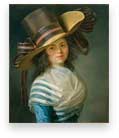 fichu: a scarf-like square of linen tucked into the bodice (or worn as a shawl) to conceal the bosom. Despite a lot of films, during the day women usually didn’t expose a lot of skin.
fichu: a scarf-like square of linen tucked into the bodice (or worn as a shawl) to conceal the bosom. Despite a lot of films, during the day women usually didn’t expose a lot of skin.
gentry, landed gentry: The landed gentry is the class from which most Jane Austen characters were drawn. They are below the nobility but may include the lower ranks of the titled, like baronets and knights. Fitzwilliam Darcy, for all his pride, is from this class, as is Mr. Bennet. Their status was also marked by the amount of land they owned and how long their family had owned it (see entailed above). Their income was derived from the land they owned (landed gentry) and farmed. Often, they did not directly farm their land but instead rented it to other gentlemen (the gentry). If you actually worked with your hands, you were not a gentleman and so they usually had managers who handled the actual business of running the estate.
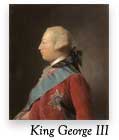 Georgian era: We often think of Jane Austen as the Regency era, but she lived most of her life before the Regency officially began (see Regency). Of course, the Regency is overlapped and subsumed by the Georgian era because the Prince Regent eventually became another Hanoverian king named George. Reputedly Austen, despite the dedication in Emma, did not think much of the Prince Regent’s dissolute ways. (Miss Austen Regrets, which is in included in a DVD package for Sense and Sensibility, dramatizes her “relationship” with the Prince Regent.) Incidentally, the Prince Regent’s father, King George III, was the king during the American Revolution.
Georgian era: We often think of Jane Austen as the Regency era, but she lived most of her life before the Regency officially began (see Regency). Of course, the Regency is overlapped and subsumed by the Georgian era because the Prince Regent eventually became another Hanoverian king named George. Reputedly Austen, despite the dedication in Emma, did not think much of the Prince Regent’s dissolute ways. (Miss Austen Regrets, which is in included in a DVD package for Sense and Sensibility, dramatizes her “relationship” with the Prince Regent.) Incidentally, the Prince Regent’s father, King George III, was the king during the American Revolution.
Interestingly, as the duties of vicar could be very light and the deacons did all the work, some vicars (for instance, Jane Austen’s father) held multiple livings.
letters patent: these were open letters issued by a monarch conferring some office, right, monopoly, title, or status to a person or to some entity such as a corporation. For instance, Charles Dundas was elevated to Baron Amesbury by letters patent issued by William IV.
Lower Assembly Rooms: The older of the assembly rooms (see assemblies) in Bath. It no longer exists, having burned down in the 1820s.
 master of ceremonies, Beau Nash: The master of ceremonies at an assembly sees that introductions are made, protocol is observed, gambling is kept under control (roll your eyes here) and that everyone has a ticket (usually delegated to someone else). Beau Nash was the most famous “emcee” at Bath, and with architect John Wood (elder and younger) and mayor Ralph Allen, made the reputation of Bath.
master of ceremonies, Beau Nash: The master of ceremonies at an assembly sees that introductions are made, protocol is observed, gambling is kept under control (roll your eyes here) and that everyone has a ticket (usually delegated to someone else). Beau Nash was the most famous “emcee” at Bath, and with architect John Wood (elder and younger) and mayor Ralph Allen, made the reputation of Bath.
Nash was called a dandy (Beau is an appellation) because of his trend-setting fashions. His position was largely self-proclaimed but real nonetheless.
money: A pound is 20 shillings, and as there are 12 pence to a shilling (aka sovereign), is also 240 pence. Five shillings make a crown, 2½ shillings a half crown and 2 shillings a florin. 21 shillings is a guinea.
Below shillings are sixpence, twopence (“tuppence”), pennies (pence), half pennies (ha’pence) and farthings (¼ pence).
 pelisse: a jacket or coat, sometimes short, sometimes full length, initially modeled after a military jacket, usually characterized by a multitude of frog fastenings and braid and originally fur trim. The thin muslin dresses of the Regency made women appreciate the pelisse, which were often made of heavy cotton or wool.
pelisse: a jacket or coat, sometimes short, sometimes full length, initially modeled after a military jacket, usually characterized by a multitude of frog fastenings and braid and originally fur trim. The thin muslin dresses of the Regency made women appreciate the pelisse, which were often made of heavy cotton or wool.
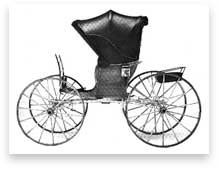 phaeton: a carriage with four large wheels, usually seating two, drawn by a single horse or tandem, often with a folding top. It was lightly sprung and considered sporty. In Pride and Prejudice, Mr. Collins says: “But [Miss de Bourgh] is perfectly amiable, and often condescends to drive by my humble abode in her little phaeton and ponies.”
phaeton: a carriage with four large wheels, usually seating two, drawn by a single horse or tandem, often with a folding top. It was lightly sprung and considered sporty. In Pride and Prejudice, Mr. Collins says: “But [Miss de Bourgh] is perfectly amiable, and often condescends to drive by my humble abode in her little phaeton and ponies.”
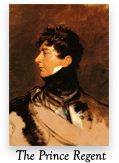 Regency: Specifically the years 1811, after King George III is deemed unfit to rule and his son is named Regent, to 1820, when his son is crowned King George IV. But more broadly the period includes the reign of George IV, which ended in his death in 1830. Some include the period up to the rule of Queen Victoria in 1837.
Regency: Specifically the years 1811, after King George III is deemed unfit to rule and his son is named Regent, to 1820, when his son is crowned King George IV. But more broadly the period includes the reign of George IV, which ended in his death in 1830. Some include the period up to the rule of Queen Victoria in 1837.
quarter days: Days on which rents were due or servants could be hired. They are Lady Day (25 March), Midsummer Day (24 June), Michaelmas (29 September) and Christmas (25 December).
solicitor, attorney: A solicitor acts directly for a client but cannot represent a client in court (see barrister). Solicitors draw up wills and contracts for clients and can retain a barrister on behalf of a client. Solicitors are in trade and not considered gentlemen, but obviously have some rank. Barristers, for instance, do not directly solicit clients but must seek work from solicitors (chasing briefs). Elizabeth Bennet’s uncle, Mr. Phillips, is a solicitor.
titled, nobility: In order of rank from highest to lowest: duke and duchess, marquess and marchioness (MAR-SHUN-ESS or MAR-SHU-NESS), earl and countess, viscount and viscountess and baron and baroness. These titles are almost always inherited with a few exceptions (life peerages). Holders of these titles are peers of the realm. Below them are baronets and knights who do sit in the House of Lords. A baronetcy is an inherited title. The author Jo Beverley has a very informative link on this subject.
ton, haut ton: in the 1892 The Stanford dictionary of Anglicised words and phrases (don’t you just love Google) ton, borrowed from the French and pronounced TONE, refers to the prevalent fashion or fashionable society, and haut ton means high society. A similar phrase is beau monde, literally “beautiful world” but we’d be more familiar with it as “the beautiful people.”
in trade: Someone in trade is not part of the gentry. You might act like a gentleman and even be treated as such, but you were always a step below. In Pride and Prejudice, for instance, Sir William Lucas was in trade, until he was knighted because of an address to the king during his mayoralty. He then essentially retired on his interest and turned his back on the business world. Mrs. Bennet, despite the affection between the families, always looked down on the Lucases because of this. Mr. Bingley is in a similar situation. His father was very rich and made his money in trade, and left his fortune, which did not include land, to his son.
Upper Assembly Rooms: The newer of the assembly rooms (see assemblies) in Bath. It is now part of the National Trust.
vicars, parish priest, rectors: Below bishops, they are the parish priests, aka vicars and rectors, who conducted services and officiated at weddings, christening and funerals. They had the benefit of a living.
John Wood (the elder and younger): This father and son team defined Palladian architecture and with Ralph Allen are responsible for Bath’s consistent Georgian appearance. The father is responsible for the Circus and Prior Park (Ralph Allen’s home) and the son for the Royal Crescent and the Upper Assembly Rooms
